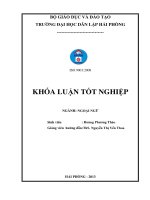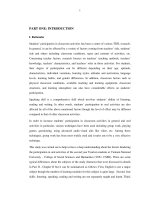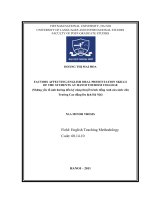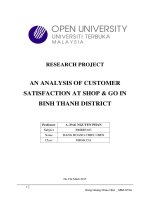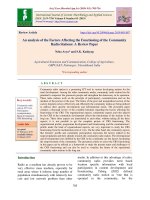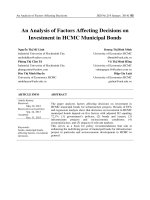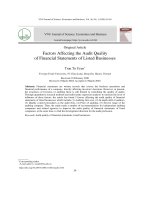6 AN ANALYSIS OF FACTORS AFFECTING THE TRANSLATION QUALITY OF SALE CONTRACTS AT GLOVIMEX COMPANY
Bạn đang xem bản rút gọn của tài liệu. Xem và tải ngay bản đầy đủ của tài liệu tại đây (809.3 KB, 54 trang )
MINISTRY OF FINANCE
ACADEMY OF FINANCE
-----�⧫�-----
Student: Vũ Vân Trang
Group:
CQ55/51.05
GRADUATION THESIS
TOPIC:
“AN ANALYSIS OF FACTORS AFFECTING
THE TRANSLATION QUALITY OF SALE
CONTRACTS AT GLOVIMEX COMPANY”
Major:
English for Finance and Accounting
Student code:
17522202010163
Supervisor:
Bùi Thị Tuyết Mai (Ms.)
Hanoi – 2021
MINISTRY OF FINANCE
ACADEMY OF FINANCE
-----�⧫�-----
Student: Vũ Vân Trang
Group:
CQ55/51.05
GRADUATION THESIS
TOPIC:
“AN ANALYSIS OF FACTORS AFFECTING
THE TRANSLATION QUALITY OF SALE
CONTRACTS AT GLOVIMEX COMPANY”
Major:
English for Finance and Accounting
Student code:
17522202010163
Supervisor:
Bùi Thị Tuyết Mai (Ms.)
Hanoi – 2021
Academy Of Finance
Graduation Thesis
DECLARATION
Vu Van Trang, hereby declare that this thesis and the study presented in it are
my own and have been generated by me as a result of my own original research.
Thesis: “An analysis of factors affecting translation quality of sale contracts
at Glovimex company”
Hanoi, May 24th 2021
Student
Vũ Vân Trang
Vũ Vân Trang - CQ55/51.05
3
Academy Of Finance
Graduation Thesis
ABSTRACT
This study researched the factors affecting translation quality of sale
contracts at Glovimex company. The paper aims at finding out drawbacks in
contract translation activities, and more importantly, suggesting main methods to
improve the efficiency of contract translation at the company. In order to achieve
these aims, the graduation paper surveys the current performance of contract
translation activities in the company and point out whether it is effective or not.
From received results, the study argues the most practical implications to improve
the efficiency of contracts translation at the company in the future years.
Vũ Vân Trang - CQ55/51.05
4
Academy Of Finance
Graduation Thesis
ACKNOWLEDGMENTS
I would like to express my deep gratitude to all those who have given me the
possibility to complete this graduation thesis. In preparing this graduation thesis, I
have had generous help and advice from my teachers, my colleagues, my family and
my friends. I would like to express my great thanks to all of them.
First of all, I would like to express my deepest gratitude to my supervisor,
M.A. Bui Tuyet Mai, lecturer of Academy of Finance, for her guidance and
instructions. It is whole-heartedly appreciated that your great advice for my study
proved monumental towards the success of this study.
Second, I wish to show my sincere thanks to all my teachers at Academy of
Finance, who have provided me with worthy lessons throughout 4 years of study.
Moreover, I am indebted to the staffs of Glovimex Company for their
valuable supports during the internship. I am extremely thankful and indebted to
them for sharing expertise, and sincere and valuable guidance and encouragement
extended to me.
Furthermore, I would like to send my loving thanks to my family whose
great love and care in both spirit and health to encourage me to complete the thesis.
Last but not least, I also place on record, my sense of gratitude to one and all, who
directly or indirectly, have lent their hand in this thesis.
Vũ Vân Trang - CQ55/51.05
5
Academy Of Finance
Graduation Thesis
TABLE OF CONTENTS
Vũ Vân Trang - CQ55/51.05
6
Academy Of Finance
Graduation Thesis
INTRODUCTION
1. RATIONALE OF THE STUDY
Globalization and an increment within the number of worldwide exchange
have driven to a considerable require of interpretation in assorted areas, counting
mass communication, education, writing, tourism, religion, science and innovation,
development, trade and business,… Different sorts of interpretation, of course, have
their highlights. Lawful document translation is often seen as the foremost
troublesome one for a few reasons. For the growing popularity of this sort of
interpretation, a interpreter has got to bargain with legal document numerous times.
Amid the interpretation prepare, troubles present to a translator, avoiding him/her
from performing his/her work well. As a translation intern, it may be a must to
discover the troubles confronting interpreters, analyze them and work out
comprehensive arrangements. In this manner, interpreters can total their work in the
most compelling way
2. AIM OF THE STUDY
The paper aims at finding out
drawbacks in contract translation activities,
and more importantly, suggesting main methods to improve the efficiency of
contract translation at the company.
3. METHODS OF THE STUDY
For better performance of challenges facing legal contract translation
activities at Glovimex company and some suggested solutions, several methods are
used,including:
i) Experiment: As required in the internship period, I have a chance to
translate
different types of legal documents. I will analyze the difficulties presenting
duringmy translating process and try to find ways to overcome them.
ii) Discussions: Further discussions with colleagues are needed. Different
translators may have their own difficulties when completing their job. Therefore,
discussions will allow looking into the issue more properly.
4. SCOPE OF THE STUDY
Vũ Vân Trang - CQ55/51.05
7
Academy Of Finance
Graduation Thesis
As specified in the title of the thesis, the thesis focuses on the legal
translation activities in Glovimex company. Because of the limited time and the
author’s knowledge, this thesis was carried out based on some specific legal
documents in the author’s internship period.
5. ORGANIZATION OF THE STUDY
The content of the thesis consists of three chapters:
Chapter 1: Literature review. This chapter focuses on some basic information
relating to translation and legal translation.
Chapter 2: Factors affecting contracts translation activities at Glovimex
company.This chapter will give an overview of Glovimex company before finding
the challenges facing translation activities and the reasons for these challenges.
Chapter 3: Recommendations: This chapter concentrates on producing
somepractical solutions to the difficulties arising.
Vũ Vân Trang - CQ55/51.05
8
Academy Of Finance
Graduation Thesis
CHAPTER 1: LITERATURE REVIEW
1.1.
An over view of translation
1.1.1. The definition
Translation, a phenomenon traditionally considered as an “art”, has existed in
every corner of our life. It has been approached from a scientific and technical point
of view and considered as an indispensable part in the field of not only literature,
culture and religion but also commercial advertisement, popular entertainment,
public administration, immigration and education….especially in this current
renovation economy. Thus, definition has been defined variously. They are defined
under many different ways which were given by a lot of famous translators
longtime ago as “Foster, Cartford, Reiss, Bell, Pinhhuck…and its definition is
continuously discovered, definited in many new ways and began to appeared in
books, dictionaries or websites. There have been a great number of books and
articles which have been written about this subject. The following are some typical
definitions which are basic theoretical background for my study:
Cartford (1965:20) considers as follows :“Translation is the replacement of
text material of this language (source language) with text material of another (target
language)”.
Hartman and Stork (1971:1) believes that :“Translation is the replacement of
a representation of a text in one language by a representation of an equivalent text
in a second language”.
Advanced Oxford Dictionary ( page 1632) defines:“Translation is the
process of changing something that is written or spoken into another language”.
According to wikipedia , translation is claimed: “Translation is the
interpreting of the meaning of a text and the subsequent production of an equivalent
text, likewise called a translation that communicates the same message in another
language. The text to be translated is called the source text, and the language that it
is to be translated into is called the target language; the final product is sometimes
called the target text.”
Vũ Vân Trang - CQ55/51.05
9
Academy Of Finance
Graduation Thesis
It is clear that the above definitions given by different linguists from different
contexts, share common features of emphasizing the importance of finding closest
equivalence in meaning with similar characteristics to the original by the choice of
appropriate target language’s lexical and grammatical structures. Some sorts of
transfer from one language to another also insist on the different methods of
translation which will be taken into consideration in the next part. Translation
methods For learners of English, there are different approaches to translation with
various methods. For a number of definitions of translation given above, we can see
that the understandings of translation varies from one to another. The central
problem of translating is whether to translate literally or freely. It all depends on
some factors such as the purpose of the translation, the nature of readership and the
text types.
And basing on the degree of emphasis on the source language and target
language, there are eight methods of translation:
The first one is Word- for- word Translation. This is the type of translation
that English learners are likely to take up in the process of mastering their
translation skills. In word-for-word translation, the source language word order is
preserved and the words are singly translated by their most common meanings, out
of context. Cultural words are literally translated. The main use of this method is
either to understand the mechanics of the source language or to construe a difficult
text as pre-translation process.
The second one is Literal translation. This is a broader form of translation,
each source language word has a corresponding target language word, but their
primary meaning may differ. The SL grammatical forms are converted to their
nearest target language equivalents. However, the lexical words are again translated
out of context. Literal translation is considered the basic translation step, both in
communication and semantic translation, in that translation starts from there. As
pre-translation process, it indicates problems to be solved.
Vũ Vân Trang - CQ55/51.05
10
Academy Of Finance
Graduation Thesis
The third one is Faithful translation. This method tries to reproduce the
precise contextual meaning of the original within the constraint of the target
language grammatical structures. It transfers cultural words and preserves the
degree of grammatical and lexical deviation from source language norms. It
attempts to be completely faithful to the intentions and the text-realization of the
source language writer.
The fourth one is Sematic translation. Semantic translation Semantic
translation differs from faithful translation only in as far as it must take more
account of the aesthetic value of the source language text, compromising on
“meaning” where appropriate so that no assonance, word-play or repetition jars in
finished version. It does not rely on cultural equivalent and makes very small
concession to the readership. While “faithful” translation is dogmatic, semantic
translation more flexible.
The fifth one is Free translation. Free translation is the translation which is
not close to the original, but the translation just transmits meanings of the source
language in her/his own words. It reproduces the matter without the manner, or the
content without the form of the original. Usually it is a paraphrase much longer than
the original. Therefore, the advantage is that the text in target language sounds more
natural. On the contrary, the disadvantage is that translating is too casual to
understand the original because of its freedom.
The sixth one is Idiomatic translation. Idiomatic translation is concerned with
communicating the meaning of the source text using the natural grammatical and
lexical items of the target language. Idiomatic translation is used for colloquialism
and idioms whose literalism is the translation by which the translator does not
transfer the literalism of the original, uses the translation of colloquialism and
idioms.
The last one is Communicative translation. This method attempts to render
the exact contextual meaning of the original in such a way that both content and
language are readily acceptable and comprehensible to the readership. “…But even
Vũ Vân Trang - CQ55/51.05
11
Academy Of Finance
Graduation Thesis
here the translator still has to respect and work on the form of the source language
text as the only material basic for his work” (Peter Newmark).
1.1.2. Process of translating
Translating procedure begins with choosing a method of approach. Then
translating with four levels more or less consciously in mind such as: source
language text level, referential level, cohesive level, and the level of naturalness.
According to PACTRANZ or Pacific International Translations, almost translators
and translation companies adopt this five-step language translation process. The
translation activity is the mental demanding task therefore the process of translating
is needed to perform well.
This is the five-step language translation process.
i)
Overview
The first step is to scope out the text that you are going to translate. It’s
important to find out the subject matter and content, how long is the text, it’s
writing style , the various section,…etc .
The translator will typically read or skim read parts of the text to get a feel
for the text. The they will note key concepts or terminology that will need to be
researched, and will decide if any preliminary background reading is
needed.Sometimes the translations for key terms will be researched and resolved
before beginning the translation.
ii)
Initial translation
In this step, the translator will systematically translate the text, about 5 to 10
words at a time. It’s important to choose the appropriate length of the text chunks to
deal. The most ideal text chunk is the text chunk with discrete and complete unit of
meaning. But it’s also don’t have to be too long to remember, the text chunk should
be short enough to be retained in short term memory. Every text chunks which is
over 10 words will be struggle to be memorized and translated.
However, sentences are frequently longer than 10 words so that it’s usually
broken down into shorter units.
Vũ Vân Trang - CQ55/51.05
12
Academy Of Finance
Graduation Thesis
Working with chunks that are too short or not discrete meaning units may
produce an unnatural and potentially unclear translations, whereas chunks which are
too long too remember may lead to some misunderstanding meaning or run the risk
of some meaning being missed.
Therefore, the act of separating the sentences into properly text chunks is
essential in the initial translation.
iii)
Revewing the accuracy of the translation.
After the first draft is completed, the translator will then methodically work
through his/her translation comparing each chunk of text with the original source
text. In this step, the translator’s work is not about translating, but more about
revising segment by segment, ensuring that the translator has made an accurate and
faithful translation of the original document; that they have completely understood
the text and not missed any information; that there have been no omissions, and that
any guidelines given by the customer have been fully complied with. Most
translators will also identify and improve any slightly unnatural or inelegant
wording in this step.
iv)
Clearing the mind
The next step is very simple one – put the translation aside and take a break.
The ideal time for a break is a few hours and overnight. This break time will help
the translator clear their mind to ensure a more effective fifth step.
v)
Final polishing
In this final stage, we know that the translation and editing stages of the text
have been completed, so in the proofreading or correction stage it should not be
necessary to refer to the original text. This final review will focus mainly on the
premise that the translated text sounds natural and reads smoothly in the target
language, in addition to detecting any inconsistencies with regard to punctuation
and capitalization. Document formatting must be checked for possible issues
relating to fonts and images, plus the document must be checked for any
typographical errors.
Vũ Vân Trang - CQ55/51.05
13
Academy Of Finance
Graduation Thesis
1.1.3. Translation quality assessment.
In order to judge the translation quality, people focus on 4 factors:
1.1.3.1 Accuracy
Accuracy in translation consists of studying the lexicon, grammatical
structure, communication situation and cultural context of the source language text,
analyzing it in order to determine its meaning and then reconstructing this same
meaning using the lexicon and grammatical structure which are appropriate in the
receptor language and its cultural context (Larson, 1998:3). Larson explained that
the accuracy test can be done by five methods:
a) comparing the translation result with the source text at several points in
the total project during the translation process,
b) after the comparison complete, do one more careful comparison.
c) when checking for equivalence of information context, make sure that the
information is include – nothing omit, nothing add and nothing different.
d) after checking to be sure that all of the information is there, make another
comparison of source language and target language text. Larson also said that
maintaining the dynamics of the original source text means that the translation is
presented in such a way that it will, hopefully, evoke the same response as the
source text attempted to evoke.
According to the statements above, the study concludes that a translation can
be said accurate if it does not deviate from the context or information on the source
text. If the result of translation does not match with the meaning on target language
and context, it can be said that the translation is not accurate. In addition, the most
important thing of the result of translation is an original work that maintains the
meaning and context from source language.
1.1.3.2 Naturalness
The naturalness in target language should be achieved in order to make the
readers of the translated version do not realize that they are reading a translation
product. Nida and Taber say that translating consists in reproducing in the receptor
Vũ Vân Trang - CQ55/51.05
14
Academy Of Finance
Graduation Thesis
language the closets natural equivalence of a source language message, firstly in
terms of meaning and secondly in terms of style. To be able to produce the closest
natural equivalence, a translator has to master the message in the original text up to
the details, then he has to restructure it. From the explanation of naturalness in
translation above, the researcher can conclude that translation should be natural in
forms of meaning and structure (grammar). So, the translators should make the
translation be equivalent and natural in the forms of meaning and structure
(grammar). They should do it in order to make the readers of the translated version
do not realize that they are reading a translation product. They can do it on many
kinds of translation.
1.1.3.3 Clarity
A good translation must say the same thing, fulfil the same purpose, and
create the same impression in the target language as did the original did in the
source . Concepts in the source text may not exist in the target culture; target
language and source language readers’ cultural norms may differ; and perhaps the
translation should recreate not the “same” impression but an “equivalent” one,
whatever that is exactly. For a great many source texts are written in commercial
settings under time pressure (time is money) by people who are not trained
professional writers, let alone literary authors with every verbal nuance at their
command. Even academics are not necessarily experts in selecting the words to
express their own ideas.Thus, a text may contain some elements that do not fully
reflect its author’s intention. It’s not that the author didn’t know their own mind or
that they are careless or – perish the thought – semi-literate. But they may leave
implications or interpretations open that they had not planned to. Ambiguities may
have crept in. The professional translator’s rigorous microscope may reveal shades
of meaning that the writer had not meant to embrace.These issues can be
problematic when the translator is striving for clarity, a noble aim to which all
translators should aspire (except perhaps in the odd case when the source text has a
wilful – oh, joy! – stylistic obscurity). And clear writing makes the
Vũ Vân Trang - CQ55/51.05
15
Academy Of Finance
Graduation Thesis
information/message/impression easier and quicker to understand completely and
accurately, thus saving readers time, effort and (therefore) money and creating a
more favourable impression of whoever produced the text. In practice, clear writing
involves sound principles such as avoiding unnecessary use of the passive voice,
eliminating needless
verbiage, and using shortish sentences
of
varied,
straightforward structure. These principles can be challenging to apply when
translating or editing someone else’s work, because of the need to be faithful, to
avoid removing any Clear writingelements or shades of meaning.
1.1.3.4 Comsistency
Linguistic consistency prevents users from finding poorly written or
unintentionally humorous content. Consistency is key to provide an accurate and
clear translation.There are 2 main types of consistency issues.The first one is
translating the same source word with different target words (when context and
meaning are identical). This leads to errors, bugs and confusion.The second one is
maintaining the inconsistency of the source in the target. It is important to know that
English is more flexible than other languages , especially when it comes to syntax.
Linguistic consistency saves us time. New translations always take time and
effort.From the user interface, to the documentation, the social media, the customer
support to the marketing texts, a company needs to address to concepts in a clear
and consistent way. Just imagine for a second one of our era giants wouldn’t care so
much about this subject. Of course, consistency problems do not end in the source
text, they are also important to solve in the target content. It is important to adapt
the terms to the target culture and accomplish a consistent language within it. This
way the user will feel the message as if it was originally written in the target
language.
1.2.
An overview of sales contract
1.2.1. The concept of sales contract
Contract, in the simplest definition, a promise enforceable by law. The
promise may be to do something or to refrain from doing something. The making of
Vũ Vân Trang - CQ55/51.05
16
Academy Of Finance
Graduation Thesis
a contract requires the mutual assent of two or more persons, one of them ordinarily
making an offer and another accepting. If one of the parties fails to keep the
promise, the other is entitled to legal redress. The law of contracts considers such
questions as whether a contract exists, what the meaning of it is, whether a contract
has been broken, and what compensation is due the injured party.
A contract of sale is an agreement between a seller and a buyer. The seller
agrees to deliver or sell something to a buyer for a set price that the buyer has
agreed to pay. With these contracts, the transfer of ownership happens when the
buyer pays and the seller delivers.This contract changes somewhat in situations
where the seller cannot yet deliver the item that is sold. It also changes when the
buyer cannot yet pay the full price. Both parties can still agree on transferring the
ownership to the person buying in these situations—as long as the seller is ready to
deliver what is being sold. The contract is then subject to resolutory condition,
meaning if the buyer fails to make the payment, the seller takes the item back.
According to The Cambridge Dictionary, they define “ contract” as “ a legal
document that states and explains a formal agreement between two different people
or groups, or the agreement itself”.
Legal Match states that “an agreement between two private parties that
creates mutual legal obligations. A contract can be either oral or written”.
There are many types of contract including sale contract.
According to the First Foundation, the definition of sale contract is that “A
sale contract is a written agreement between a buyer and seller of real estate, setting
forth the terms of the sale, and specifying the rights and duties of the parties in the
real estate transaction. It will be signed by the buyer and seller and their witnesses
and will become legally binding upon each party”.
For example, Mr. McGillicuddy wishes to sell property to Mrs Danforth.
After agreeing on a price, closing date, and other terms of the sale, Mr.
McGillicuddy’s attorney prepares a sale contract. It is reviewed and signed by Mr.
Vũ Vân Trang - CQ55/51.05
17
Academy Of Finance
Graduation Thesis
McGillicuddy and Mrs Danforth. The parties are now legally bound by the terms of
the contract and it will govern the sale transaction.
A sale contract is the basis of the real estate transaction, it is in large part the
“law” the parties agree to bind themselves to. In the event of a dispute in the future,
the terms of the real estate will control and define the dispute.
According to Upcounsel, the definition of sale contract is that “A contract of
sale is an agreement between a seller and a buyer. The seller agrees to deliver or sell
something to a buyer for a set price that the buyer has agreed to pay. With these
contracts, the transfer of ownership happens when the buyer pays and the seller
delivers.”
1.2.2. The importance of sales contracts
A sales contract is an agreement between a seller and a buyer which includes
the delivery and sales of goods, various securities, and many other personal
properties. it is also known as sales or goods agreement or purchase agreement. A
sales contract is always advantageous as it reduces the risks of loss and company
getting sued. A proportion of risk reduces by mentioning terms of a particular
agreement clearly and get it signed from all the important parties. Doing this will
provide you grounds to take legal action in the failure of meeting conditions
mentioned in the contract.Besides reducing risks of the lawsuit, contracts are useful
to provide clarity to employees and both seller and buyer. Sales contract contains all
important details related to contract and expectations from each party. Contracts
make both parties stay true to what they have agreed on while writing a contract and
avoid risks of the lawsuit.
To prepare a detailed and accurate sales contract takes a lot of both time and
money. A company has to hire a lawyer to get constructed an airtight and detailed
sales contract and hiring a lawyer costs you a lot of money. In addition to this, it
takes a lot of time to form accurate and detailed contracts, because it is required to
discuss with both parties concerned and design contract as per the specifications of
both parties. Making a sales contract involves various things to talk about and it
Vũ Vân Trang - CQ55/51.05
18
Academy Of Finance
Graduation Thesis
creates an unpleasant atmosphere among all the members who are responsible for
signing the contract. This not only built suspicion among the people but also
increase the chances of the lawsuit as both parties will do their best to saves itself
from the risks and be less concerned about another party.
1.2.3. Characteristics of sales contract
According to the Project Jurisprudence, the sale contract has 6 main characteristic:
1, “A contract of sale is consensual because the contract is perfected by mere
consent. This is different from a real contract (perfected by delivery). Paras (2008)
explains that a real contract is one perfected by delivery and he gives, as example, a
contract of deposit or commodatum. In a real contract, the agreement does not start
to operate unless the thing or the person (over and/or for which the contract is
made) is placed in the control of one of the parties. Therefore, being consensual, a
contract of sale does not require delivery of the thing sold/bought. Such delivery is
merely an obligation on the part of the seller (vendor), which he must perform right
after perfection, after delivery to him of the purchase price, after a period or after
the happening of a condition, etc.”
2, “According to Paras, a contract of sale is a bilateral reciprocal contract
because both parties are bound by obligations dependent upon each other. In other
words, it is bilateral because both parties are obliged to perform an obligation (the
seller delivers; the buyer pays). It is reciprocal because the one party's obligation
becomes demandable the moment the other party performs his obligation.
Therefore, the moment the seller places the buyer in possession of the thing
due, the latter, absent any stipulation to the contrary, should deliver the purchase
price to the former. The same is true vice versa.”
3, “A contract of sale is onerous because, to acquire the rights, valuable
consideration must be given. Cause or consideration is a general requirement for the
existence of contract. What is referred to here is valuable consideration (in
pecuniary terms). Compare a contract of sale with a deed of donation; the latter does
not require, as a rule, a valuable consideration from the done”
Vũ Vân Trang - CQ55/51.05
19
Academy Of Finance
Graduation Thesis
4, “A contract of sale is commutative, as a rule, because the values
exchanged are almost equivalent to each other. This is the presumption because, in a
normal contract of sale, the seller sells and the buyer buys at a price at which both
of them are willing to sell and buy. Generally, when persons buy something, they
think that what they get is equivalent in value to the money they have to pay.”
5, A contract of sale is principal because for it to validly exist, there is no
necessity for it to depend upon the existence of another valid contract. In other
words, it is principal because it can exist independently.
6, A contract of sale is nominate because the New Civil Code of the
Philippines refers to it by a special designation or name, i.e., the contract of sale.
There are contracts not mentioned in the Code such a contract where a person lets
another live in his house in exchange of a daily back massage. These contracts not
specifically or specially named by the Code are called innominate contracts.
1.2.4. Elements of contract of sale.
It is very important to mention a detailed and vivid description of goods in
the sales contract. Mentioning all these details accurately will ensure that the seller
will deliver company correct product. In the failure of getting the correct goods,
company can take legal actions on the basis of the sales contract. However, all other
problems with the agreement can be neglected as long as the buyer is getting the
products that he has asked for.
Late delivery, delivery at wrong address or careless delivery can cause
problems and can disrupt the production or sales process. therefore, it is very
important to mention the correct date, time and place of delivery of goods clearly. In
addition to this, company sales contract should also mention who will be
responsible for the loss of goods or any other mishappening.
“Inspection period” is one section that most buyers forget to include in a
sales contract. This period will give time to the buyer to inspect the goods deliver to
him and reject any different goods. However, the inspection time is different for
different types of goods. For example, goods which have a short shelf life
Vũ Vân Trang - CQ55/51.05
20
Academy Of Finance
Graduation Thesis
(perishable goods) are required to accept or reject immediately. However, expensive
goods such as machines a buyer requires a little longer time (for a week or a month)
to inspect goods and take the decision of accepting or rejecting goods.
It is common to neglect the warranties set by the seller for the goods.
However, neglecting warranties can be risky as no one can predict how a thing will
come out in the future. Besides this, there is no standard format for warranties on
goods and it varies from industry to industry and company to company.
This is the most important part after the description of goods in a sales
contract. Mentioning the total price of goods is important. However, it is also
important to mention all other payment details to avoid any type of confusion in the
future. the payment details should include whether the payment will be made in
installments or single transaction, will buyer have specific criteria to get paid.
In addition to this, in case if the buyer is not paying the right way then it is
wise to include a promising note or have a separate promising note to mention
payment terms in more detail. In the note, company can also mention whether the
interest will be incurred by the seller or not for the delay in the payment.
Vũ Vân Trang - CQ55/51.05
21
Academy Of Finance
Graduation Thesis
CHAPTER II: SITUATION OF TRANSLATION QUALITY OF SALES
CONTRACTS AT GLOVIMEX COMPANY
2.1.
General imformation about GLOVIMEX company
2.1.1. Brief introduction about GLOVIMEX company
Company Name: Glovimex Company Limited
Established: 2015
Address: No.18/67 Chua Lang Street, Dong Da District, Hanoi, Vietnam
Contact:
· Telephone : +84 24 3201 1341
· Fax : +84 24 3201 1341
· Email :
· Website : www.glovimex.com
. Company size: 11-50 employees
2.1.2. Business areas of company
Producer of Handicraft Items made of Plant Fibers
· Trader of Handicraft Products, Hand-made Encaustic Cement Tiles
Bank Account: Joint Stock Commercial Bank for Investment and Development of
Vietnam (BIDV)
GLOVIMEX Co., Ltd. was founded in 2015 by a group of year experienced
professionals worked for Vietnam Rural Industrial Development Promotion Agency.
Through close relationship with Vietnamese artisan for years, and with
understanding of Vietnam traditional handicraft products, GLOVIMEX was
established for promotion of Vietnam traditional craftmanship to the world. We are
an independent company operating in production, trading, wholesale high-quality
handicraft products formed by skillful hands of craftsmen.
With inherent advantages of tropical vegetation diversity, Vietnam citizen have
utilized many kinds of plant fiber to create daily living utensils as well as equipment
and tools for centuries. These products have now been improved and more aesthetic
aiming for descor or fashion. On the other hand, it is safe to use of handicraft
Vũ Vân Trang - CQ55/51.05
22
Academy Of Finance
Graduation Thesis
products due to toxic-free. Therefore, we always hope our products to gain a firm
foothold in the hearts of customers around the world for eco-living in the future.
Our Mission
· Satisfy customers by focusing on creation and perfection of products, delivering
exceptional, personalized, and flexible products and services.
· Understand customers’ needs in order to make a harmonious combination between
Vietnam traditional handicraft items with the demand of eco-living.
Our Vision
· Become a worldwide respected supplier in the field of production and trading
Vietnam handicraft products.
· Find out and provide new alternative business solutions for benefit of our
customers and for the growth of our stakeholders.
Business Type :Manufacturer
Main Products :Handicraft Products made of Bamboo, Rattan, Jute, Seagrass, Water
Hyacinth such as: Lamp Shade, Basket, Tray
Main Markets :America, Asia, Europe, Oceania, Middle East
Established year: 2015
Total Annual Revenue:US$2.5 Million - US$5 Million
Export Percentage:71% - 80%
Address :Nha 4, 105/8 Lang Ha, Dong Da
Country: Vietnam
Key Products:Handicraft Products made of Bamboo, Rattan, Jute, Seagrass, Water
Hyacinth such as: Lamp Shade, Basket, Tray
Other Products:Handicraft Products, Encaustic Cement Tiles, Eco-friendly Utensils.
Vũ Vân Trang - CQ55/51.05
23
Academy Of Finance
Graduation Thesis
2.1.3. Organizational structure of the company
Board of Glovimex Company
The above diagram describes the current organization structure of Glovimex.
At the highest position is Board of Directors which represents the company before
law. The Chairman of the Board of Directors is a person with full authority to
perform the rights and obligations on behalf of the company. Following is the
General Director who responsible to the Board of Directors for production,
business, management and the use of capital. The company have a Vice Director
and Deputy General Director of Production Division and a Vice Director and
Deputy General Director of Branch. There are four different divisions and each
division has its own departments. Moreover, every department have Manager or
Team Leader. This person performs professional work; plan and coordinate work
with the Board of Directors; propose reward and punishment.
The Marketing Department is in the Office Division, it is the head of
planning and implementing promoting activities and company’s branding. The
department currently consists of three people in charge, one of whom is in charge of
Vũ Vân Trang - CQ55/51.05
24
Academy Of Finance
Graduation Thesis
the overall marketing plan, one in charge of marketing & sales, and one in charge of
digital media. In addition, the department also has a team of 3 collaborators and
interns who help with seeding and promoting products.
Human resource situation at the company
The labor statistics at the end of 2018, 2019 and 2020 are as follows:
●
2018: 102 people
●
2019: 121 people
●
20120: 154 people
(Source: Human Resource Department)
According to this, the number of employees has increased over the last 3
years. The number of total labor in 2019 increased by 19 people compared to 2018;
in 2020, the number go up for 33 people compared to 2019. Overall, this
information shows that the Company's labor force is tend to increase rapidly.
At the present, the company's total labor force is 154 people, of which 65%
is female and 35% is male, which lead to a conclusion that the number of female
employees in the company accounts for a large proportion. This is due to the fact
that the company trades in a unique product with female employees primarily;
thereby facilitating the management of female workers in general. But this labor
structure also greatly affects the operation of the company in the case of a series of
female employees taking maternity leave or giving birth, requiring the company to
have a reasonable policy to overcome its situation.
Glovimex company attaches great importance to the recruitment and training
in order to have well-qualified and professional employees who meet their work
efficiency. In general, labor qualification of Glovimex company is very high (in
2020, university level accounted for 70.6%). With the growing trend of
globalization and fierce competition, improving labor qualifications is becoming
more and more necessary than ever.
The age of the employees is mostly from 19 to 35 years old, accounting for
70% of the labor force in 2020. The company is focusing on recruiting young staff
Vũ Vân Trang - CQ55/51.05
25
